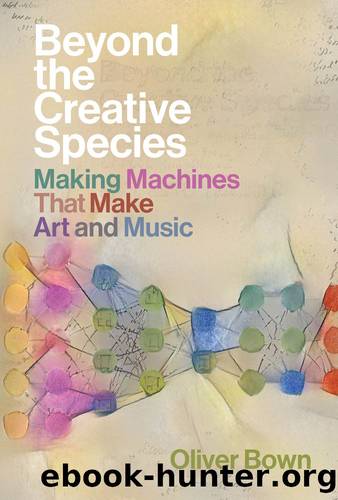Beyond the Creative Species: Making Machines That Make Art and Music by Oliver Bown

Author:Oliver Bown [Bown, Oliver]
Language: eng
Format: epub
Tags: generative; computational creativity; algorithmic automation;
ISBN: 9780262045018
Google: tSAXEAAAQBAJ
Publisher: MIT Press
Published: 2021-07-15T00:32:58.457013+00:00
In another visual art example, Eric Chu proposes an âArtistic Influence GANâ or AIGAN,45 in which the generator of a network trained on a specific style takes as input an additional vector representing influencers, thus producing outputs purporting to be Artist A influenced by Artist B: âWhat if Banksy had met Jackson Pollock during his formative years, or if David Hockney had missed out on the Tate Galleryâs famous 1960 Picasso exhibition? How would their subsequent art differ?â
Jean-Pierre Briot and François Pachet46 review methods of musical style transfer in musical domains, noting that much of the work in this area focuses on more explicit forms of âstructure imposition,â where specific structural qualities are applied from one piece to the âmusical textureâ of another piece. This includes using the longer-term structure of a piece, as determined by the pieceâs self-similarity (a measure of how similar sections of the piece are to other sections of the same piece).
Cross-domain synthesis deals with situations in which content in one domain is used to generate content in another domain, such as generating text from images. This can be done using supervised learning. For example, a similar approach to an autoencoder can be used, this time with the stimulus matched with the expected output. One of the more obvious and common areas of application of this is between text descriptions and media. Machine learning systems have long demonstrated success in generating text descriptions from images, but more recently, GANs have been used to generate images from text descriptions. In this case the generator learns a mapping from a description to an image, and the discriminator learns to discriminate between real and generated images, given the text description.47
Closely related to such text-to-content generation is the idea of generating content that satisfies specific aesthetic or psychological criteria, such as to make happy or sad music. This can be done in a wide variety of ways (for example, Monteith, Martinez, and Ventura use Markov models.)48 Alternatively, we might want to create sensible combinations of elements, such as animated images that go with a piece of music or vice versa.
The Creative Capacity of Machine Learning SystemsâBig data and deep learning have opened up impressive new avenues for the automated generation of content. Large datasets of written language, speech, music, images, and so on can be fed into these systems to train them on specific styles. In music, you might use one of the many research datasets, such as the Luxembourg folksong database, stored in machine-readable MIDI49 form, commonly used by researchers for experimental purposes. Note that usually the dataset simply dictates what is typical of a given art form, rather than necessarily what is good or bad. We train machine learning systems on Bach or Picasso with the expectation of making things that sound or look like Bach or Picasso. Thus it is perhaps easy to dismiss such systems as merely concerned with imitation and fakery.
What kind of creative potential do we expect machine learning systems to have? Given their
Download
This site does not store any files on its server. We only index and link to content provided by other sites. Please contact the content providers to delete copyright contents if any and email us, we'll remove relevant links or contents immediately.
Whiskies Galore by Ian Buxton(41800)
Introduction to Aircraft Design (Cambridge Aerospace Series) by John P. Fielding(33045)
Rewire Your Anxious Brain by Catherine M. Pittman(18530)
Craft Beer for the Homebrewer by Michael Agnew(18123)
Cat's cradle by Kurt Vonnegut(15152)
Sapiens: A Brief History of Humankind by Yuval Noah Harari(14210)
Leonardo da Vinci by Walter Isaacson(13147)
The Tidewater Tales by John Barth(12595)
Thinking, Fast and Slow by Kahneman Daniel(12023)
Underground: A Human History of the Worlds Beneath Our Feet by Will Hunt(11997)
The Radium Girls by Kate Moore(11899)
The Art of Thinking Clearly by Rolf Dobelli(10174)
A Journey Through Charms and Defence Against the Dark Arts (Harry Potter: A Journey Throughâ¦) by Pottermore Publishing(9209)
Mindhunter: Inside the FBI's Elite Serial Crime Unit by John E. Douglas & Mark Olshaker(9160)
Tools of Titans by Timothy Ferriss(8186)
Wonder by R. J. Palacio(7974)
Turbulence by E. J. Noyes(7920)
Change Your Questions, Change Your Life by Marilee Adams(7610)
Nudge - Improving Decisions about Health, Wealth, and Happiness by Thaler Sunstein(7541)
